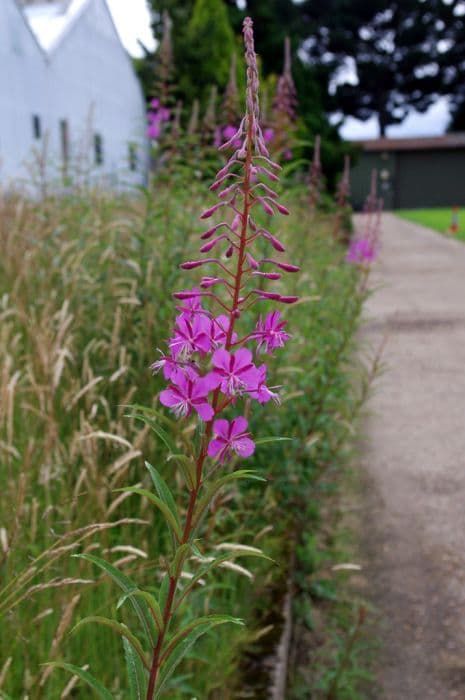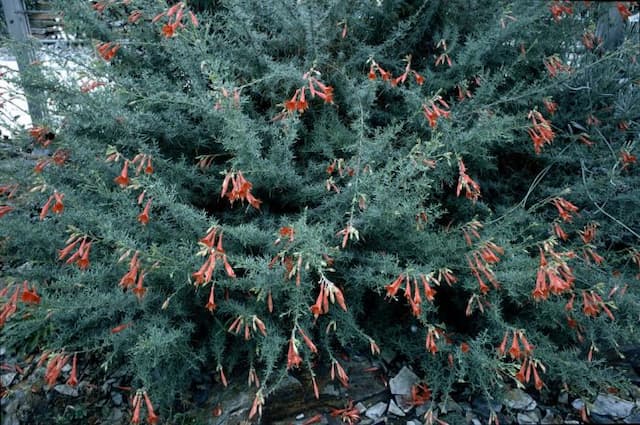Fuchsia Fuchsia 'Traudchen Bonstedt' (T)

ABOUT
Fuchsia 'Traudchen Bonstedt' is an ornamental plant known for its striking and unique flowers, which are a primary feature of its appearance. The flowers are pendulous and possess a graceful form that captures the eye. They have a two-tone color scheme with the outer parts often displayed in a delicate pink to purple shade, while the inner petals and sepals contrast strikingly in a deeper purple or sometimes reddish hue. The plant's foliage is also attractive, presenting dark green leaves that create a lush backdrop for the showy blooms. The leaves are usually oval-shaped and may have a slight serration along the edges, adding texture to the plant's overall aesthetics. Given the right conditions, 'Traudchen Bonstedt' can produce an abundance of flowers that dangle elegantly from the branches, creating a cascading effect that enhances its ornamental value. The flowering season for the plant typically spans from late spring through to fall, offering a prolonged display of its beautiful blossoms. Overall, Fuchsia 'Traudchen Bonstedt' is prized for its distinctive blooms and the touch of elegance and vivid color it brings to gardens and containers.
About this plant
 Names
NamesSynonyms
Lady's Eardrops, Fuchsia
Common names
Fuchsia 'Traudchen Bonstedt'.
 Toxicity
ToxicityTo humans
Fuchsia, including the 'Traudchen Bonstedt' cultivar, is not considered toxic to humans. In general, fuchsias are regarded as safe, and some parts of the plant are even edible, such as the berries which are sometimes used in making jams. However, eating non-edible parts of the plant, like the leaves or flowers, is not advisable as it can potentially cause mild digestive discomfort or an allergic reaction in some individuals.
To pets
Fuchsia, including the 'Traudchen Bonstedt' cultivar, is also not considered toxic to pets. It is generally regarded as safe for animals, including dogs and cats. Although the plant is not poisonous, ingestion of large amounts of non-edible plant material could potentially lead to gastrointestinal upset, such as vomiting or diarrhea, in pets. As with any non-food plant, it is best to prevent pets from eating fuchsias to avoid any potential issues.
 Characteristics
CharacteristicsLife cycle
Perennials
Foliage type
Deciduous
Color of leaves
Green
Flower color
Pink
Height
1-2 feet (30-60 cm)
Spread
1-2 feet (30-60 cm)
Plant type
Shrub
Hardiness zones
9
Native area
Central and South America
Benefits
 General Benefits
General Benefits- Ornamental Value: The plant produces attractive and pendulous red and purple flowers, enhancing the visual appeal of gardens and landscapes.
- Habitat for Wildlife: It offers nectar, which attracts hummingbirds, butterflies, and other pollinators, supporting biodiversity.
- Versatility: Fuchsia 'Traudchen Bonstedt' can be grown in hanging baskets, containers, or as bedding plants, offering flexibility for gardeners with different space constraints.
- Shade Tolerance: This variety of fuchsia can thrive in partial shade, making it suitable for garden spots that do not receive full sunlight.
- Long Blooming Period: It has a long flowering season that typically lasts from spring through fall, providing sustained color in the garden.
- Low Maintenance: While it needs regular watering and some care, it is relatively low maintenance compared to other flowering plants.
 Medical Properties
Medical PropertiesThis plant is not used for medical purposes.
 Air-purifying Qualities
Air-purifying QualitiesThis plant is not specifically known for air purifying qualities.
 Other Uses
Other Uses- Fuchsia 'Traudchen Bonstedt' can be used in fairy gardens due to its delicate flowers and attractive foliage, creating a whimsical miniature landscape.
- This plant serves as an excellent subject for botanical illustration and art, providing intricate detail and vivid colors for artists to capture.
- Fuchsia is suitable for bonsai, allowing gardeners to apply the traditional Japanese art form to this Western favorite with careful pruning and shaping.
- The nectar-rich flowers of Fuchsia are a natural choice for attracting hummingbirds to the garden, providing a food source for these birds.
- Because of its pendant-like blooms, Fuchsia can be utilized in hanging glass terrariums to add a cascade of color indoors or in sheltered outdoor settings.
- The vibrant blossoms of Fuchsia can be used to make natural dyes for textiles, offering a range of colors from pinks to purples depending on the mordant used.
- With its bright flowers, Fuchsia 'Traudchen Bonstedt' can be incorporated into edible landscapes as an ornamental feature that is also safe if incidental consumption occurs.
- This plant's unique appearance makes it suitable for use in themed events and ceremonies, like weddings, to create exclusive decorations or bouquets.
- The plant can act as a living mulch under taller plants or trees, providing ground cover that helps retain soil moisture and suppress weeds.
- Fuchsia flowers can be used in the culinary world as an exotic garnish for desserts and cocktails, adding a pop of color and light, slightly acidic flavor.
Interesting Facts
 Feng Shui
Feng ShuiThe Fuchsia is not used in Feng Shui practice.
 Zodiac Sign Compitability
Zodiac Sign CompitabilityThe Fuchsia is not used in astrology practice.
 Plant Symbolism
Plant Symbolism- Confidence - The Fuchsia 'Traudchen Bonstedt' is known for its vibrant, hanging flowers, embodying confidence as it shows off its stunning blooms boldly and proudly.
- Elegance - With its graceful drooping flowers in striking color combinations, this plant is often associated with elegance and poise.
- Good Taste - Historically, fuchsias have been a staple in Victorian gardens, a period characterized by refined aesthetic tastes, hence the association with good taste.
- Overflowing Abundance - The profusion of blossoms that the Fuchsia 'Traudchen Bonstedt' produces can symbolize an overflowing abundance, reflecting generosity or a wealth of emotions.
- Welcoming - The inviting appearance of the fuchsia's flowers, along with its hospitable habit of blooming throughout the season, allows it to be a symbol of openness and warm reception.
 Water
WaterLady's eardrops should be kept consistently moist without becoming waterlogged. Water when the top inch of soil feels dry to the touch, which during the active growing season could mean watering every day or two. Generally, use about 1 gallon of water per plant each week, adjusting based on temperature and humidity. Make sure to water directly at the base to avoid splashing the leaves, which can lead to disease. During winter dormancy, reduce watering frequency to prevent root rot.
 Light
LightLady's eardrops flourish in bright, indirect light with protection from harsh afternoon sun. A spot that offers morning sun and afternoon shade or dappled sunlight throughout the day is ideal. Avoid deep shade, as it can lead to poor blooming, and direct midday sun, which can scorch the delicate foliage.
 Temperature
TemperatureLady's eardrops thrive in temperatures between 55 and 75 degrees Fahrenheit but can tolerate a range as wide as 40 to 80 degrees Fahrenheit. Protect the plant from temperatures below 40 degrees, as it can cause cold damage. Ideal growing conditions are cool with high humidity, emulating their natural mountainous and forested habitats.
 Pruning
PruningPrune Lady's eardrops to shape the plant, encourage bushier growth, and remove dead or diseased branches. The best time to prune is in late winter or early spring before new growth begins. Lightly trim throughout the growing season to promote a neat appearance and abundant blooms. Major pruning should generally be done annually.
 Cleaning
CleaningAs needed
 Soil
SoilFuchsia 'Traudchen Bonstedt' requires a soil mix that is rich, moist, and well-draining with a pH of around 6 to 7. A mix of peat moss, perlite, and loam works well, providing aeration and moisture retention for optimal growth.
 Repotting
RepottingFuchsias, including 'Traudchen Bonstedt', generally should be repotted annually, preferably in the spring. Young plants grow quickly and can benefit from twice annual repotting.
 Humidity & Misting
Humidity & MistingFuchsia 'Traudchen Bonstedt' thrives in high humidity conditions. Aim for a humidity level between 60 to 70% for optimal growth.
 Suitable locations
Suitable locationsIndoor
Place in bright indirect light, ensure high humidity.
Outdoor
Hang in dappled shade, shelter from strong winds.
Hardiness zone
6-11 USDA
 Life cycle
Life cycleThe Fuchsia 'Traudchen Bonstedt', commonly known as Lady's Eardrops, begins its life cycle from a seed, which upon germination, grows into a young seedling with a rudimentary root system and a pair of initial leaves. The seedling stage is followed by the vegetative growth stage, in which the plant develops a robust root system, stems, and foliage, becoming more established and gradually maturing. After the vegetative stage, the plant enters the flowering phase during the warmer months of the year, producing distinctive pendulous blooms that are pink to purple in color, which attracts pollinators and facilitates cross-pollination. Following pollination, the plant sets fruits in the form of small berries that contain numerous tiny seeds, completing the process of sexual reproduction. When conditions become unfavorable, particularly in colder climates, Fuchsia 'Traudchen Bonstedt' may enter a period of dormancy, shedding leaves to conserve energy. The plant will stay dormant until favorable conditions return, at which point it will resume growth and begin the cycle anew.
 Propogation
PropogationPropogation time
Spring-Early Summer
The most popular method of propagating Fuchsia 'Traudchen Bonstedt' is through softwood cuttings. This technique is usually done in spring when new growth is tender and flexible. Gardeners select healthy, non-flowering shoots that are about 2 to 4 inches (5-10 centimeters) long, and make a clean cut just below a leaf node. The lower leaves are stripped off, and the stem is sometimes treated with rooting hormone to encourage root development. The cutting is then inserted into a pot filled with a well-draining soil mix, ensuring at least one node is below the soil surface. The environment should be kept humid, often achieved by covering the pot with a plastic bag, and placed in indirect light. Roots typically form within 3 to 4 weeks, after which the new plants can be gradually acclimated to less humid conditions and eventually transplanted outdoors.









